Did Pfizer Roofie the Placebo Babies?
Saline injections are not supposed to have such an aggressive side effects profile. So what exactly was in Pfizer's placebo injection?
Note: This is a work in progress, the primary objective in writing this was to put the data in a nice, organized series of screenshots, hopefully someone has time to do a deeper dive into these anomalies. I’m still too busy with the case reports.
FDA Fact Sheets for Healthcare Providers:
***********************************************************************
In what may be another pandemic first, it looks as though Pfizer’s baby trials may well be the first drug trial where the placebo arm is in blatant contravention of the Nuremberg Code.
Daniel Horowitz wrote a great piece that really does a good job explaining how Pfizer & Moderna graduated from employing fraudulent methodologies to plain fraud:

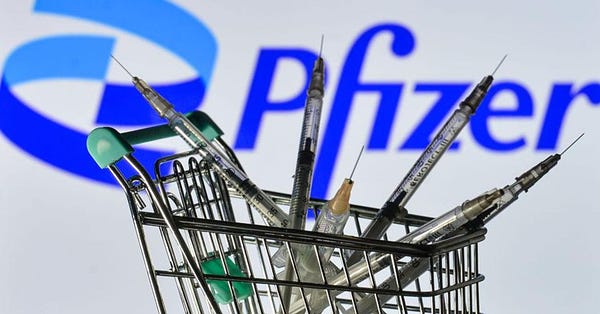
One of the more curious anomalies from the Pfizer baby trial pointed out by Horowitz is the unusually high incidence of systemic reactions to what Pfizer claims is a saline injection:
6) Now that we've established that, at best, there is no long-term benefit to these shots for anyone, much less babies, let’s go on to the adverse events. On the surface, Pfizer’s own report is an indictment of the shot’s safety. Table 21 on page 42 states that 61% of babies 6 months to 2 years old experienced a “systemic reaction within 7 days.” This means that it’s not just irritation of the injection site but something more along the lines of fever, chills, or muscle aches. Right off the bat, that should be disqualifying, because that is the upper bounds of discomfort the kids would suffer from the virus anyway. The only rebuttal to this is that almost as many placebo group patients experienced such reactions. But that in itself should be an indication there is something fraudulent with the placebo group. It’s understandable for even a saline injection to cause irritation at the injection site, but “systemic” reactions?
Did Pfizer spike their placebo? That’s a legitimate question given these unexpectedly high rates of systemic reactions.
So I figured that it might be instructive to take a look at the rate of systemic reactions for all of the other 5 age cohorts along with the granular data on the specific side effects.
Comparing the various arms from Pfizer’s own vaccine trials seems to me to be the best (and easiest) analysis pound for pound to do first. Unlike going through historical drug or vaccine trials, or even the Moderna / J&J/ AstraZeneca trials, Pfizer trials should (emphasis on “should”) be basically comparable, for sure regarding the content and protocol for the placebo arms. Differences between age cohorts from the various Pfizer trials therefore can be more readily attributed to deviations of one sort or another from Pfizer’s claim that the placebo babies (and everyone else too for that matter) were given saline injections (page 25):
And guess what?
It’s a mess.
I don’t know how to interpret this data, but it’s worthwhile to present the unresolved ambiguities, one side effect1 at a time (screenshots of all the data below from the FDA Fact Sheets linked above in this footnote).2
“Solicited Systemic Reactions”
Fever
The best side effect to use for a comparison is fever, because fever is very objective and is measured for every age group. Fever is also measured by thermometers instead of PCR tests, so we can actually be confident of the test results. (I am not emotionally able to entertain the possibility that the thermometers are corrupted as well, even if they are. Too much.) After all, it is somewhat challenging to inquire of a 9 month old infant if he or she has joint pain.
The Fever disparities are also the biggest red flag that the placebo babies got spiked placebo.
The difference in the rate of placebo fever between the tots and everyone else really jumps right off the page:
As you can see, in every single category both groups of babies had a higher incidence of fever than all other groups combined (and they have a 4:1 advantage).
It would seem highly improbable that the exact same placebo could cause such wildly disparate rates of systemic reactions. It is likewise improbable that good old fashion saline would produce this high an incidence of fever.
But there’s more. For the babies, the placebo seems to have been as potent an immunological provocateur as the vaccine.
Here are the fever incidence rates for all doses of all arms of all the trials (color scheme is for loose reference, not for making definitive adjudications):
The following are some of the oddities in this:
As stated above, the incidence rate for every single level of fever except >40C for both baby groups i higher than the combined total of the other FOUR age groups.
The placebo beats the vaccine arm half of the time in provoking fevers. And they are in the same magnitude generally.
In the *Booster* dose - the one where the vaccine should really do a number on the poor babies because of dose accumulation - in the 2-4yo group the placebo caused roughly 150% the rate of severe fevers caused by the vaccine. And for both baby groups, the dose 3 combined fever rates were fairly close between the V&P.
In the non-baby age groups, there is a dose-dependent connection between the fever incidence rates caused by the vaccine - dose 2 is always way higher than dose 1.
Paradoxically, the Dose 2 fever rates from the vaccine in the 12+ cohorts is 2-3x the rate of fever incidence of all the baby doses whether vaccine or placebo.
The 12-15 group for some reason is a massive outlier for dose 1 fevers in the vaccine group. They also are far and away the highest fever rate for every single dose for all fevers (except >40 which is negligible).
All the other minor inconsistencies and oddball numbers floating around in there.
So…
What on earth was in these placebos (and vaccines for that matter)?? There seems to be very little consistency between age groups, and the equivalence between the placebos & vax group in the babies is downright bizarre.
One theory that has gotten some traction is that Pfizer’s saline placebo contained the lipid nanoparticles (LNP’s) without any mRNA. Since the LNP’s are highly inflammatory and go pretty much everywhere, it would produce a similar pattern of systemic reactions to the vaccine.
This explanation is not that straight forward however. For instance, when Pfizer happily blew up the control arm by vaccinating the placebos, does this mean that Pfizer was going to subject the control group to *SIX* doses of LNP’s? That would be a gamble, to say the least. But there are some strange anomalies here and in the rest of the side effects that don’t exactly jibe together that well.
There is of course the possibility that Pfizer could have given only some of the placebo babies the placebo, swapping out the LNP’s in the rest of the placebo babies for, well, saline. They could also have given different babies the “placebo” for different injections to prevent compounded dose toxicity when they subsequently vaccinated the control group (or to keep the side effects manageable in the placebo, we have no idea if empty LNP’s might provoke a different reaction than LNP’s with immune-suppressing components in their payload mRNA such as the pseudo-uridine. Like they were allegedly providing for the entire placebo group.
This is worth repeating: We have reached the point where it is actually prudent to consider the possibility that Pfizer strategically replaced their placebo with saline for part of their placebo group in order to avoid the side effects of their placebo.
Especially because as we shall see, this pattern does not replicate for all of the other side effects.
Headaches
Headaches seem to have a similar pattern with fevers, which makes sense, as a headache is probably the most commonly associated symptom with fever.
One thing especially pronounced in the headaches is the age-dependency. It looks like a covid epidemiological curve. And the V/P split is dose dependent for pretty much everyone except the tots - gets larger the more doses you go.
Irritability
This one is an exclusive infant stat (this table is formatted a bit different because it’s only the 6mo-2yo group):
As you can see, not much difference between the vaccine and the placebos for any dose or severity except severe irritability, which is absent from the placebo in doses 1 & 3, but eclipses the vaccine in dose 2. Getting stabbed by a long needle is definitely an experience liable to leave little Johnny or Sally quite irritable though, especially if done by an incompetent buffoon who has no healthcare experience. There’s even a phenomenon of physical trauma injury to the tissue being stabbed by the syringe called SIRVA (Shoulder Injury Related to Vaccine Administration), such as the following three case reports:
Chills
There’s no data on chills for the infants under 2yo (kind of hard to ask them).
Oddities:
The 5-11yo are in on the action now too - you don’t see the differentiation between the V/P shoot up a cliff until the 12+ groups.
The booster placebo for the babies again comes through to hold its own with the vaccine.
The rates of vaccine chills for the older groups dwarfs the younger groups. (I suspect that this might be at least in part a result of little kids lacking the necessary sophistication to articulate and/or differentiate chills from feeling generally sick. Also, the rate in the 5-11 group is almost double that of the babies, which is further supports this theory. However chills are a similar type of reaction to fever, so it does make sense that if the fever rates are lopsided, the chills rates would be too.)
The dose dependency is again present for all age groups except the babies. Even the 5-11 group about doubles from vaccine dose 1 to dose 2.
Vomiting
The yummy stuff. Let’s see (I forgot to put in the blue/green, sorry about that, I’m too lazy to go make new screenshots now):
The absence of the infants makes sense - it’s unusual for infants *not* to be constantly spitting up food randomly at the worst times too. So it would be pretty hard to reach statistical significance with less than 548,228 babies (where you can discern a signal between for instance 99.837% vs 99.842% throwing up, which are probably accurate depictions for real-life).
The moderate vomiting first placebo for the 2-4 group is an outlier. The 2-4 group is markedly worse than everyone else for some reason. What’s really weird is the booster placebo is much worse than the vaccine booster - as in THREE times as bad overall (!!) - and that’s despite being pretty even for the first two doses. Definitely at least a little suspicious.
Joint Pain
This one is plain weird:
for the baby group & the 5-11 group, dose one placebo is almost 2x worse than the vaccine.
it then almost flips for dose 2
and then gets to V/P equilibrium more or less for the booster dose.
clear dose-dependency in vax for older groups
but since when do 12-15yo compete with gramps for worst arthritis??
older groups get hosed by joint pain way more than the younger two groups <12.
for older groups, placebo goes down from dose 1 - dose 2.
baby group could be underreported. How many 2yo do you know who even know what a joint is? I have 2yo nieces, they can talk, but I would be shocked if one of them would declare to have joint pain - they would say “my arm hurts ‘here’ (‘here’ often being a very expansive anatomical geography).
This does not seem to make for a coherent picture. Almost like the <12 & >12 got vastly different products…
Muscle Pain
Yet again, we have the paradox of V/P equivalence in the younger groups but both at vastly lower rates than the older groups more or less. There looks to be some degree of age dependency until you hit the 18-55 group, which suggests that there may be a significant URF that goes up as the age goes down.
Diarrhea
Everyone’s favorite!
(The diapered babies are excluded for very obvious reasons. Whereas 1yo vomit - spit-up - is kind of cute, the toxic volcanic eruption of poo is most certainly not (and as every parent of adorable cooing clumps of cells is well aware, unfortunately when it really matters most diapers seem to have about as much efficacy at stopping ‘transmission’ as the covid vaccines). So trying to measure this by subjective parental reporting is unlikely to yield any useable information or data.)
Seriously, did the babies get a laxative in the placebo? The P convincingly holds its own against the V for the tykes. And there is very little daylight between the V & P for all age groups/doses (except for some odd reason 5-11yo dose 1).
Fatigue / Drowsiness (Infants)
Everyone wins somewhere at fatigue!
Yes, the rates of mild fatigue in Vaccine Dose 2 are 21.4, 21.1, 21.1, 21.1 - I double checked the screenshots from the FDA docs (below in footnote 2). Quite a coincidence though lol.
2-11 groups dose 1 V/P basically equal
2-4 diverges from 5-11 for doses 2/3 - in 5-11 group, vax dose 2 clearly asserts its fatigue supremacy vs the placebo
For doses 1&2, V/P fairly even for infants.
For infants, dose 1 placebo is (barely) higher than vaccine for every severity level. Go figure.
12-15 dose 1 placebo is worse than vax for everyone else (except 18-55 which narrowly ekes out a victory 47-40).
etc.
Again, it’s hard to spot a consistent pattern here among age groups that makes sense… if the placebos were indeed saline at least.
“Solicited Local Reactions”
Swelling
The infants are back!
Swelling in the <12 groups is way higher than for the >12 groups in the placebos. Also, the 5-11 V/P2 shouldn’t be in blue/green cuz it is a massive outlier for both the V & P. The reverse dose-dependency in the baby groups’ placebos & from vax dose 2 to dose 3 but positive dose dependency in the vax dose 1 to dose 2 is a bit strange.
Injection Site Pain (Tenderness in the infants)
I’m not sure what to make of these. The poor 5-11yo get hosed again though.
The injection site is markedly worse in the vaccine arms for all age groups. But the difference between V/P is exponentially higher in the older groups.
Also the dose-dependency is gone (it’s actually even a bit negative half the time), which implies that the injection site is mostly just the initial immune reaction to being injected, or the first-line superficial reaction to whatever is being injected. (There are a number of case reports about delayed injection site/skin reactions that manifest after 7+ days.) So it’s interesting that there is a clear difference between the V/P in the babies - does this mean that Pfizer actually gave some of them real placebos (maybe there were extra adult saline doses leftover from all those vaccine vials that nobody wants anymore)? Who knows.
Redness
Wow do the younger three groups do worse by orders of magnitude here. But the 5-11 has a much wider gap between V/P than either baby group.
What I really don’t get is why there is such a steep falloff from the 5-11 to the 12-15 groups. Or why the 5-11 has similar rates of mild redness to the baby groups but then stands out like Everest for moderate redness? There seems to be a pattern here showing that the 5-11 vax was also… unique. (It almost seems like the 5-11 got baby placebo with their supped-up vax. Best of both worlds?)
Misc
Pain Meds
This is a great category, because there is a certain objective measure that people take pain meds because they feel like they’re in pain, and so is a good barometer of general degree of suffering (or a parent’s suffering from a colicky baby).
Yup, the parents who signed up their infants for medical experimentation are also the quickest to pump said infants full of painkillers. Or perhaps the poor babies really needed them?
Regardless, here you can see a clear age-dependent split between V/P for all doses & a dose-dependent split between V/P for 5+ groups.
The 5-11 group really seems to have gotten the worst of both worlds across the board for most ide effects, with similar placebo rates to the babies but much larger vaccine advantage over the placebo as well.
Total Local & Systemic Effects for Babies
They only had this for the baby trial:
This one chart highlights a critical point: While the local effects are skewed to the vaccine arms, the systemic effects are pretty evenly balanced between V/P.
This is exactly the opposite of what we would expect. Local effects, especially in little babies, would be expected from injecting anything.
Systemic effects, on the other hand, are not expected from inert placebos in significant numbers. Especially something innocuous like saline, which is exactly what we see in the adult groups. It’s like the saline was imported through the southern border & got laced up with drops of fentanyl.
What does this all mean?
This data is a big mess. There definitely seems to be something off with much of the stats here, particularly the high rates of certain systemic side effects & the unexpectedly even balance between the vaccine and placebos for certain side effects in the baby trial and to some extent for the 5-11 trial as well.
It’s hard to know what can be extrapolated from this data. But there sure seems to be a heck of a lot of smoke billowing out from the Pfizer trials, and we know that most of them already have massive wildfires ripping through them as it is.
In the final irony here, it turns out that the JAMA study was right after all - the placebo does indeed account for the local and systemic side effects.
If anyone spots any errors, please please drop a comment3!! Thanks :)
For the record, these only include what are called “solicited” side effects, ie typical side effects that are not generally serious and happen with practically any medical intervention, even placebos (just not supposed to happen this much, especially compared to the actual drug being tested).
If someone has a more efficient way to pull the data into excel from PDF & use clunky uncooperative formulas that keep messing things up, I would be very appreciative, 3/4 of the time spent writing this article was spent making the excel & screenshots.




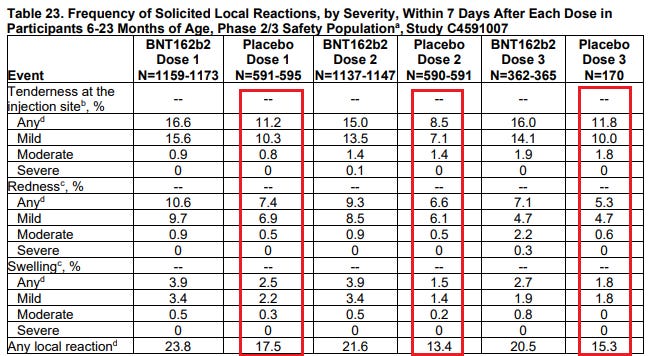
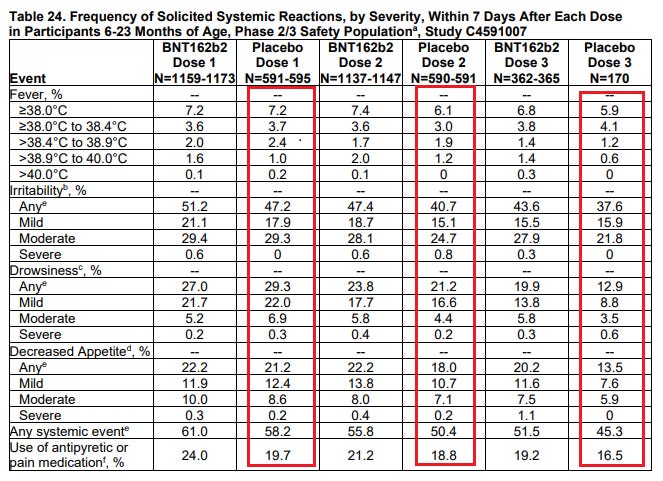
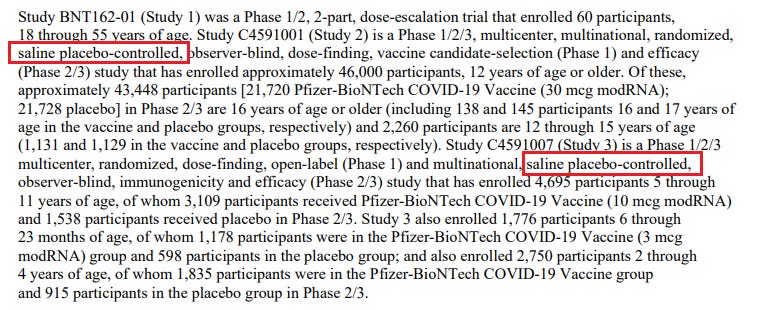
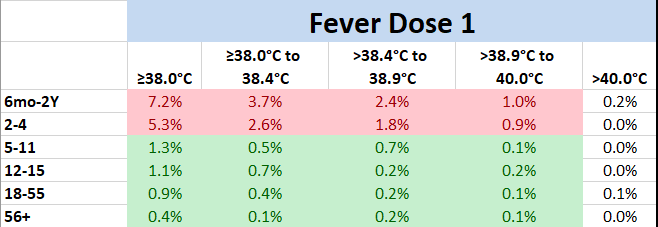


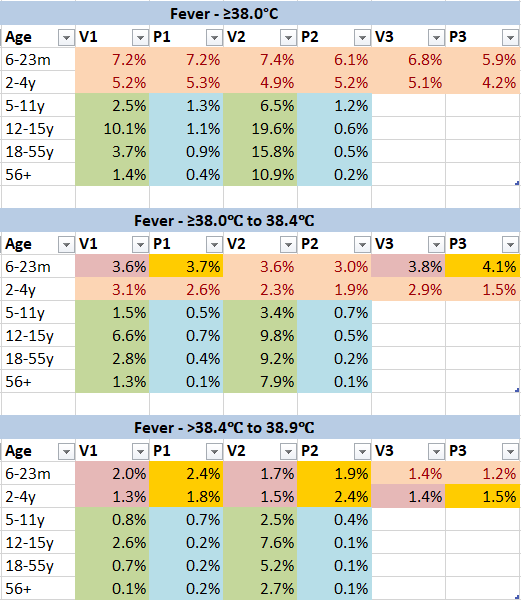
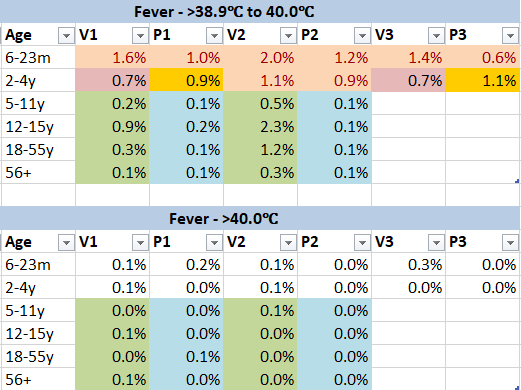
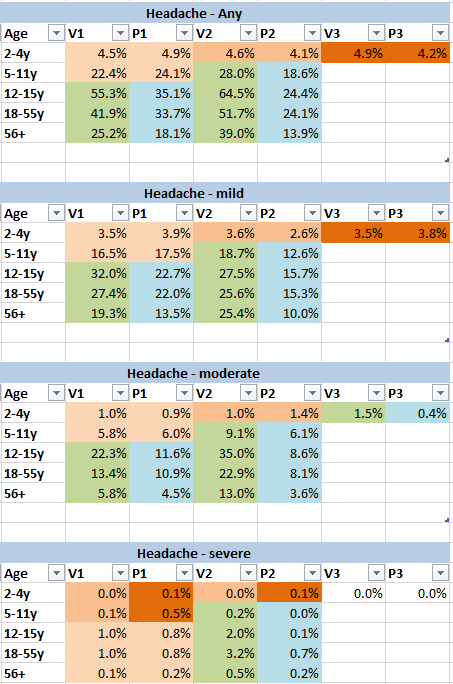



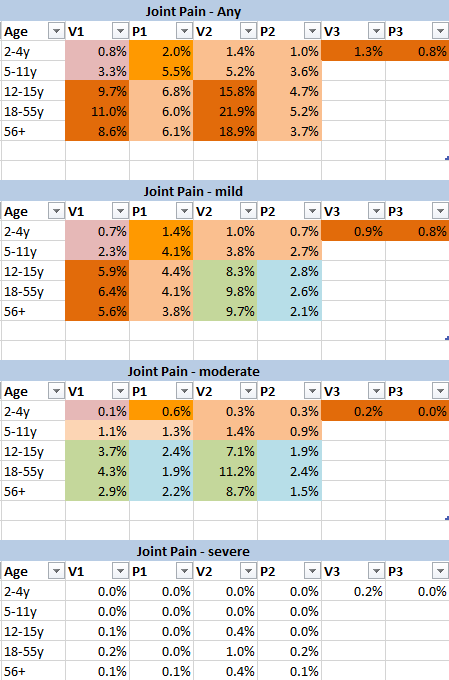
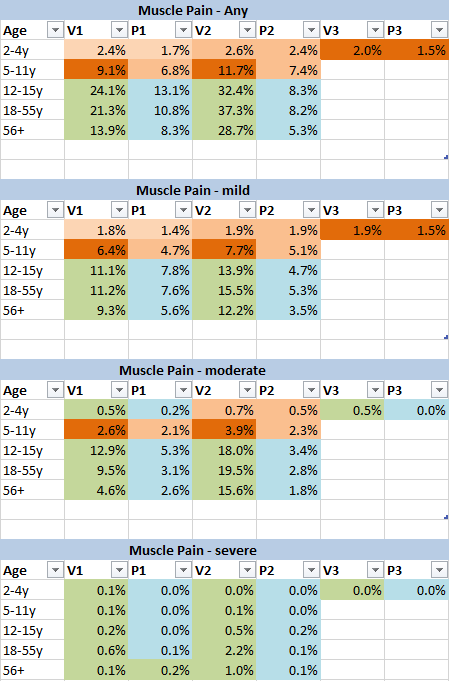


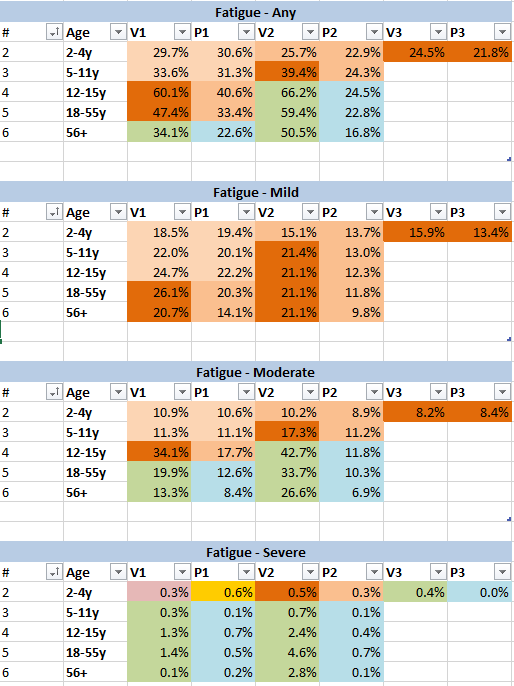
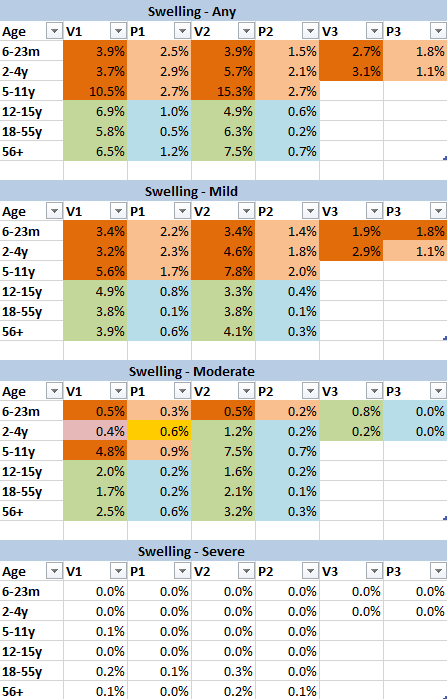

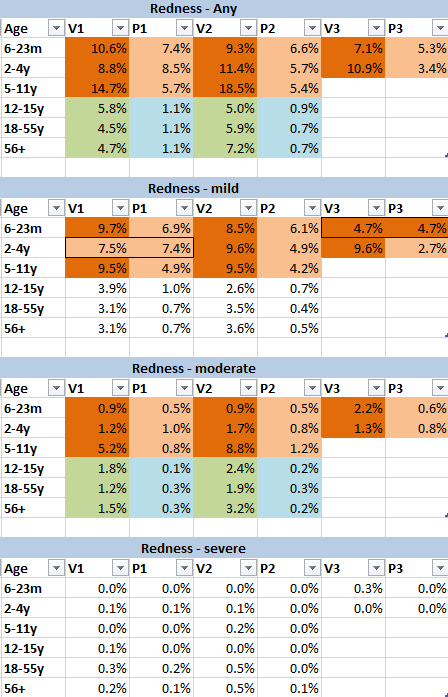




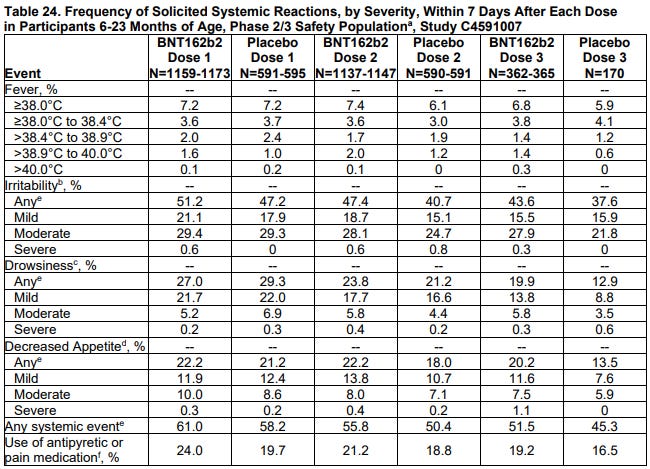
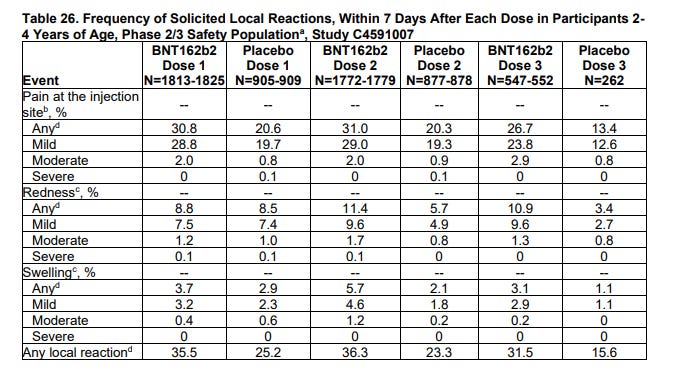
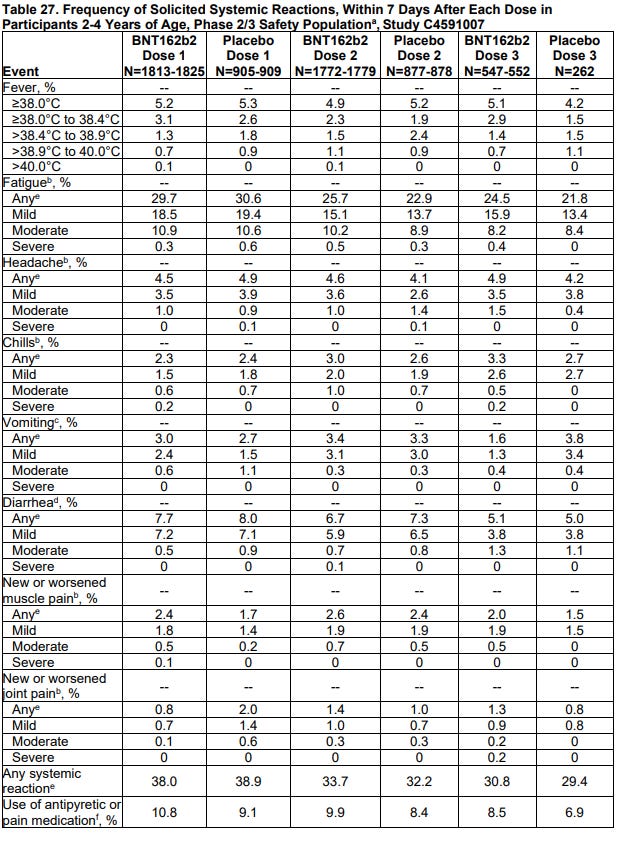

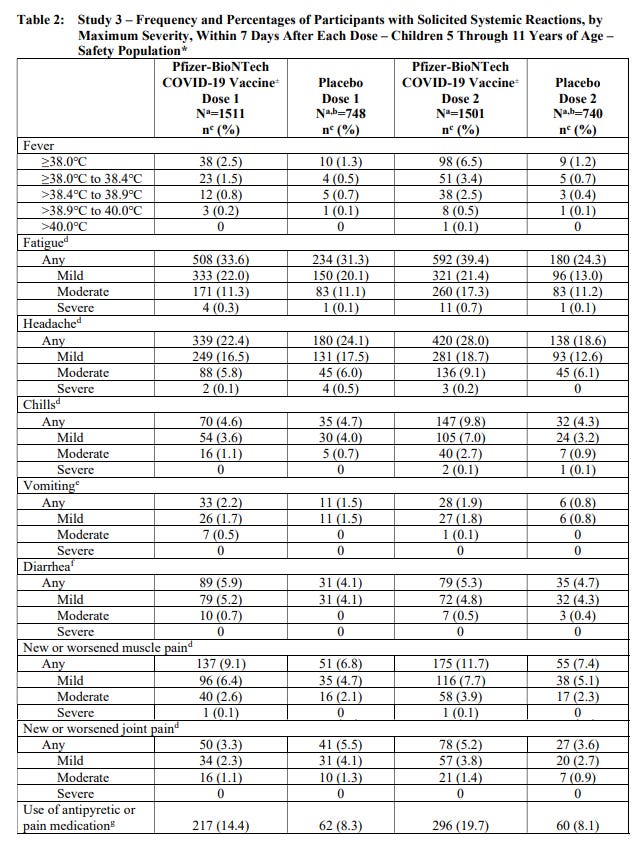
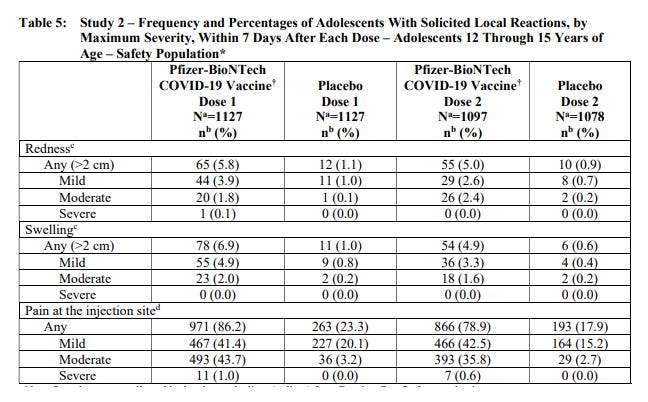


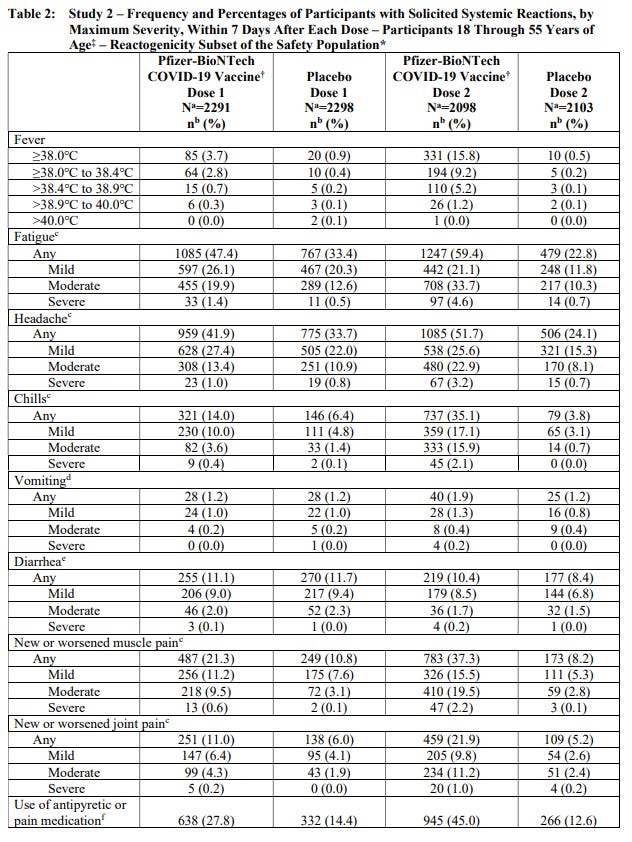
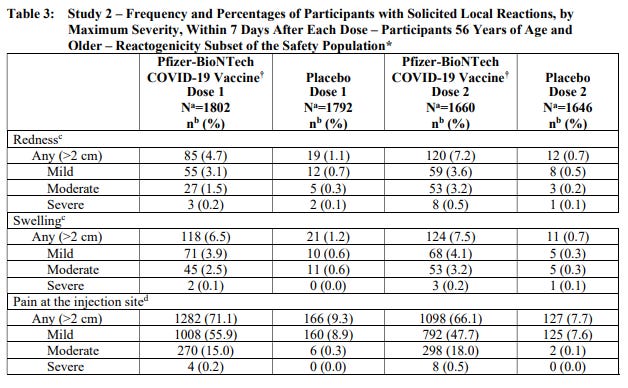
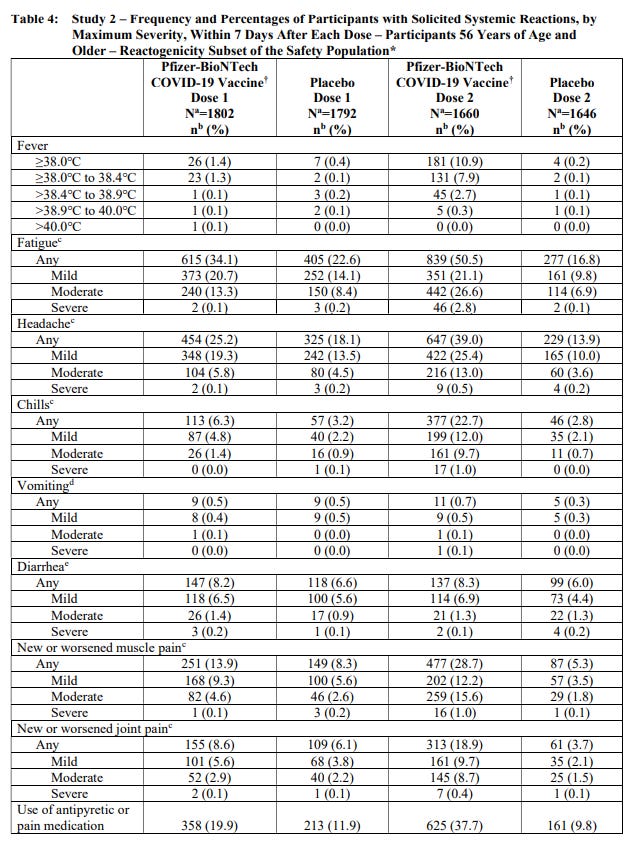
Thank you for all of this! 🙏💕 The past trials of vaccines already on the childhood vaccination schedule were often not tested against a placebo, but tested against another vaccine. I wonder if Pfizer has defined "placebo" in this trial... And now I'm reading the other comments where you say they defined saline placebo. Barefoot healer might be onto something, what is the concentration of salts in their saline solution....?
There was a story last year that indicated that they were not using a saline solution, but had used another, different kind of vaccine in some of their trials.